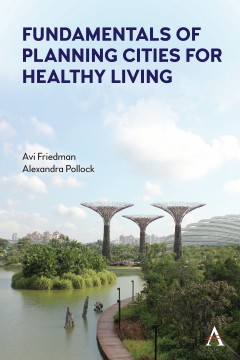Fundamentals of Planning Cities for Healthy Living
By Avi Friedman & Alexandra Pollock
- About This Book
- Reviews
- Author Information
- Series
- Table of Contents
- Links
- Podcasts
About This Book
Current planning and design modes of dwellings and neighbourhoods are facing challenges of both philosophy and form. Past approaches no longer sustain new demands and require innovative thinking. The need for a new outlook is propelled by fundamental changes that touch upon environmental, economic and social aspects.
The depletion of non-renewable natural resources, elevated levels of greenhouse gas emissions and climate change are a few of the environmental challenges that force designers to reconsider conceptual approaches in favour of ones that promote a better suitability between communities and nature. Consideration of overall planning concepts that minimize the development’s carbon footprint, district heating, passive solar gain, net-zero residences and preserving the site’s natural assets are some of the contemporary strategies that architects, planners and builders are integrating into their thought process and residential design practice.
Increasing costs of material, labour, land and infrastructure have posed economic challenges with affordability being paramount among them. The need to do with less brings about concepts that include denser places, adaptable and expandable dwellings, and smaller-sized yet quality designed housing. Also, the need to reduce utility costs gave rise to better insulation, which benefits both the environment and the occupant.
Social challenges are also drawing the attention of designers, builders and homeowners. As the “baby-boom” generation plans for retirement, housing an elderly population will take priority. Walkable communities, ageing in place and multigenerational living are some of the concepts considered. In addition, live-work environments have become part of the economic reality for those who wish to work from home – which has become possible through digital advances.
The need to think innovatively about neighbourhoods led to the idea to write this book. The intention is to offer information on contemporary community design concepts and illustrate them with outstanding international examples.
Reviews
“The connection between health and the built environment is of ever more urgent concern. Avi Friedman and Alexandra Pollock provide a concise but comprehensive overview of how urban design and planning can lead to better health. Drawing on the most recent research, the authors cover a remarkably broad array of design and planning interventions and dimensions of health. The book has much to offer whether one is interested in the broad connections between urban form and public health or how urban design and planning can improve particular aspects of health.” —Alex Schwartz, Professor, Chair, Public & Urban Policy MS Program, Milano School of Policy, Management, and Environment, USA.
“A timely and critically needed analysis of the many contemporary issues facing our cities. Finally, we have a well-written and interconnected approach to what planning has done, or failed to do, in addressing the many social and physical ills of our cities, towns, and neighborhoods. An essential read for planning for healthy cities in 2022.” —Michael Fox, PhD, Research Professor in Community-Engaged Learning, Mount Allison University, Canada.
“Friedman and Pollock’s Fundamentals of Planning Cities for Healthy Living brings together the breadth of knowledge on urban design and public health in a fresh and effective manner. It uses clear and accessible writing and will be a valuable resource for practicing planners and planning students. Integration of current global public health data and issues such as COVID along with the use of international examples makes this a new and important scholarly work.” —Rob Buchan, PhD, FCIP, RPP, Adjunct Professor, Simon Fraser University, President of iPlan Planning and Development Services.
“This book explains Smart city concepts and presents relation of form, function and health; physical health and mental health that is not covered in most of the city planning books. It explains how to integrate the elements of the city to form healthy and sustainable environments via innovative design, practices and methods. The trend towards cleaner air, carbon-neutral economy has been accelerated, it also makes a useful contribution to urban planning for healthy living, and resilient, livable, and healthy settlements design.”— Dr. Ebru Karahan, Özyeğin University.
Author Information
Avi Friedman is a professor of architecture at McGill University and the principal of Avi Friedman Consultants, Inc.
Alexandra Pollock holds a degree in urban systems from McGill University. She is a researcher at Avi Friedman Consultants, Inc., specializing in sustainable planning.
Series
Table of Contents
Preface; Acknowledgments; The Broad View; Form, Function, and Public Health; Planning for Active Mobility; Green Open Spaces; Active Life in Winter Cities; Socializing in Communities; Food Production and Distribution; Urban Design for Healthy Aging; Public and Multi-Unit Residential Buildings and Public Health; Healthy Residences; Equitable Health Promotion; Bibliography; Bibliography for Case Studies; Illustrations’ Credits; Index
Links
Stay Updated
Information
Latest Tweets



